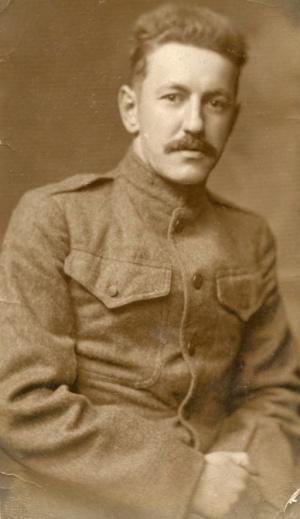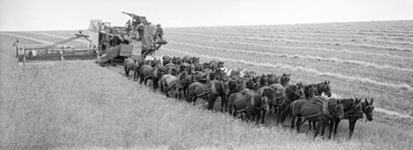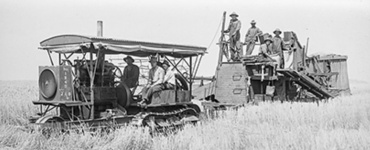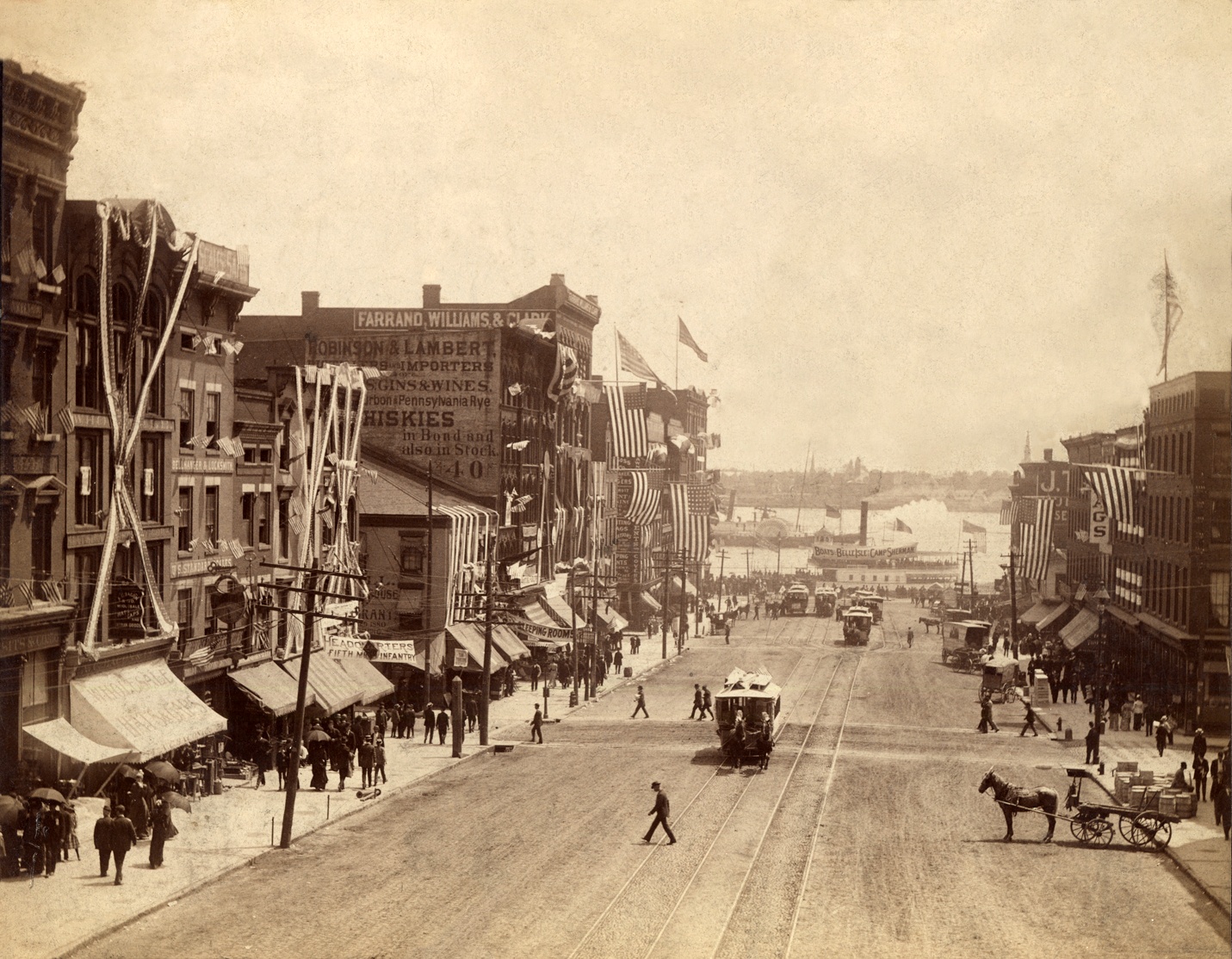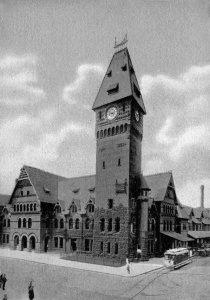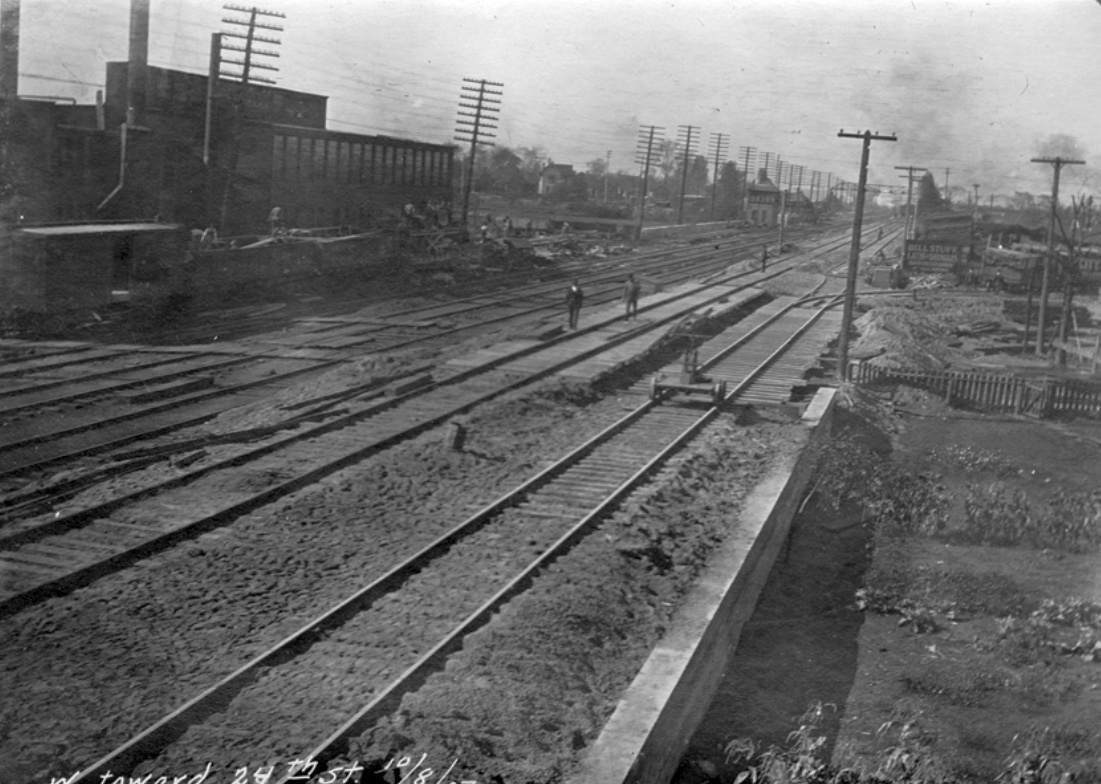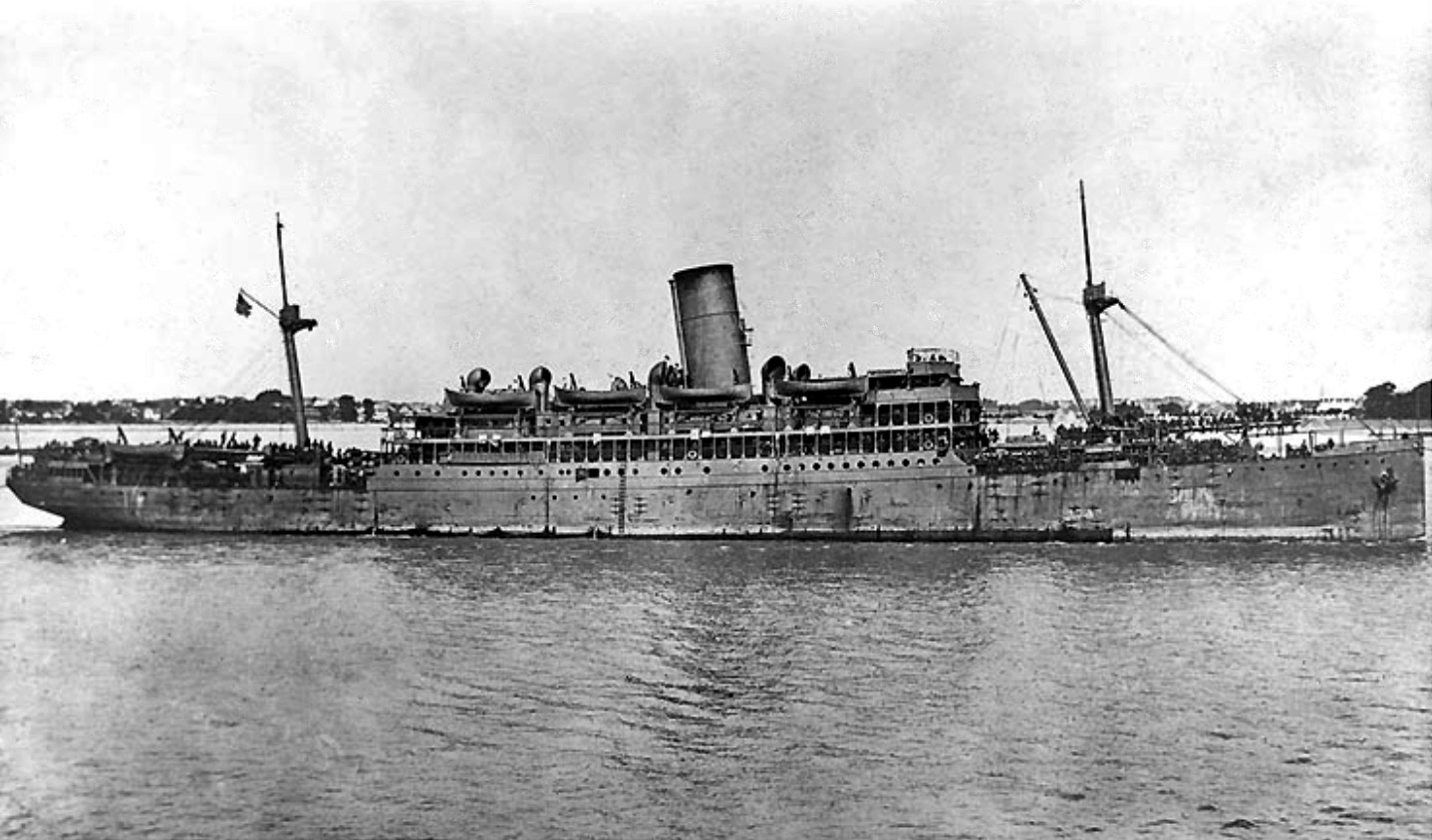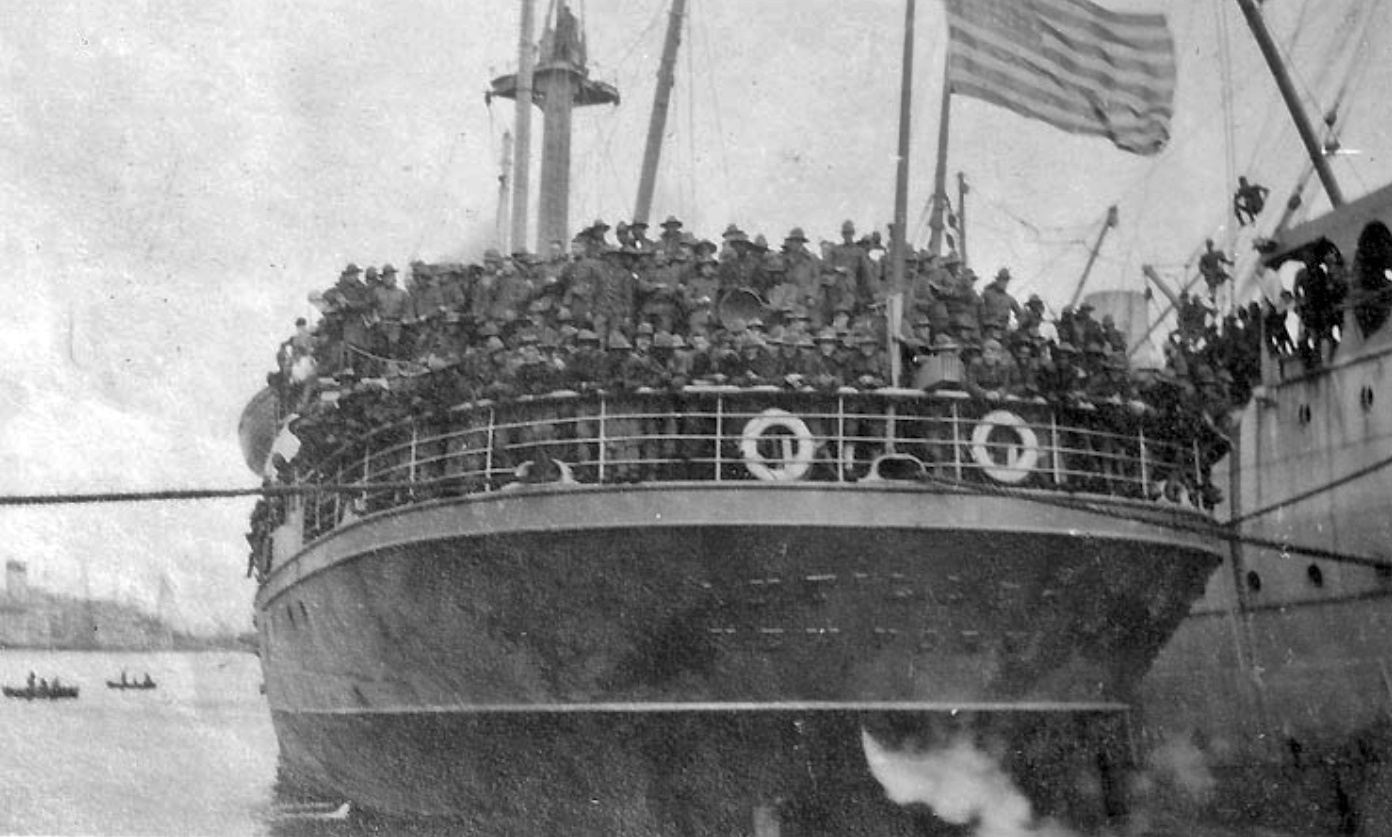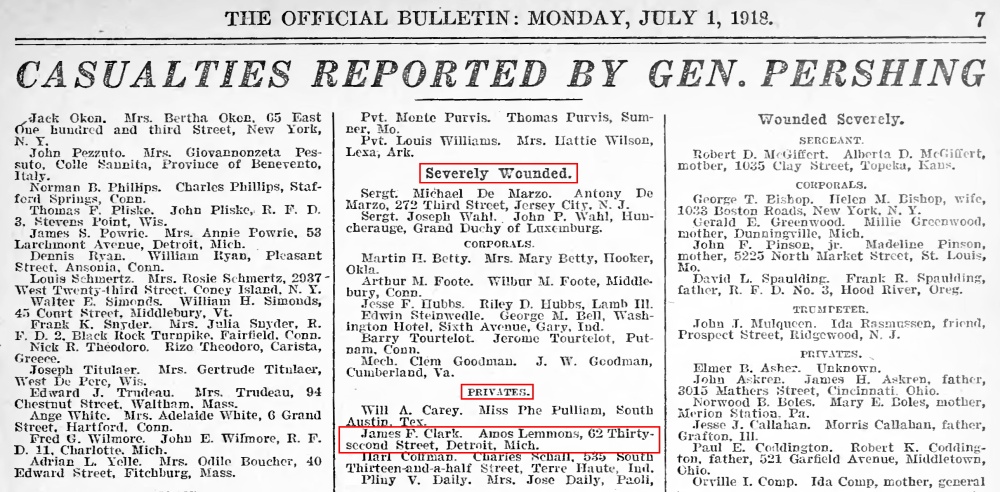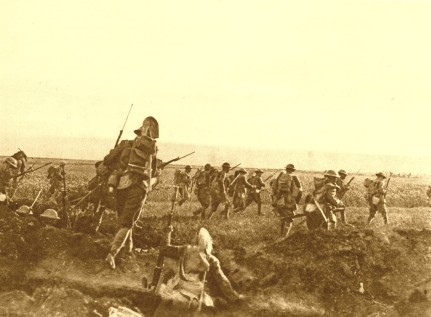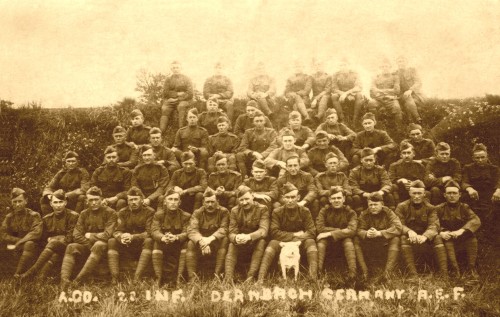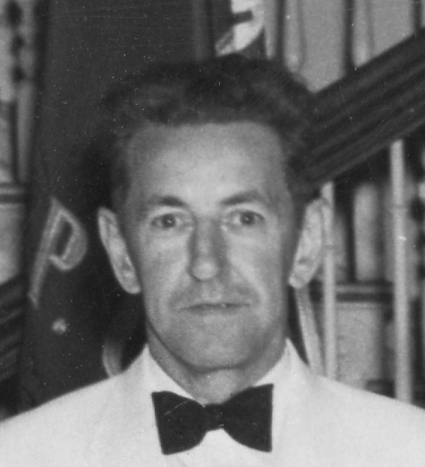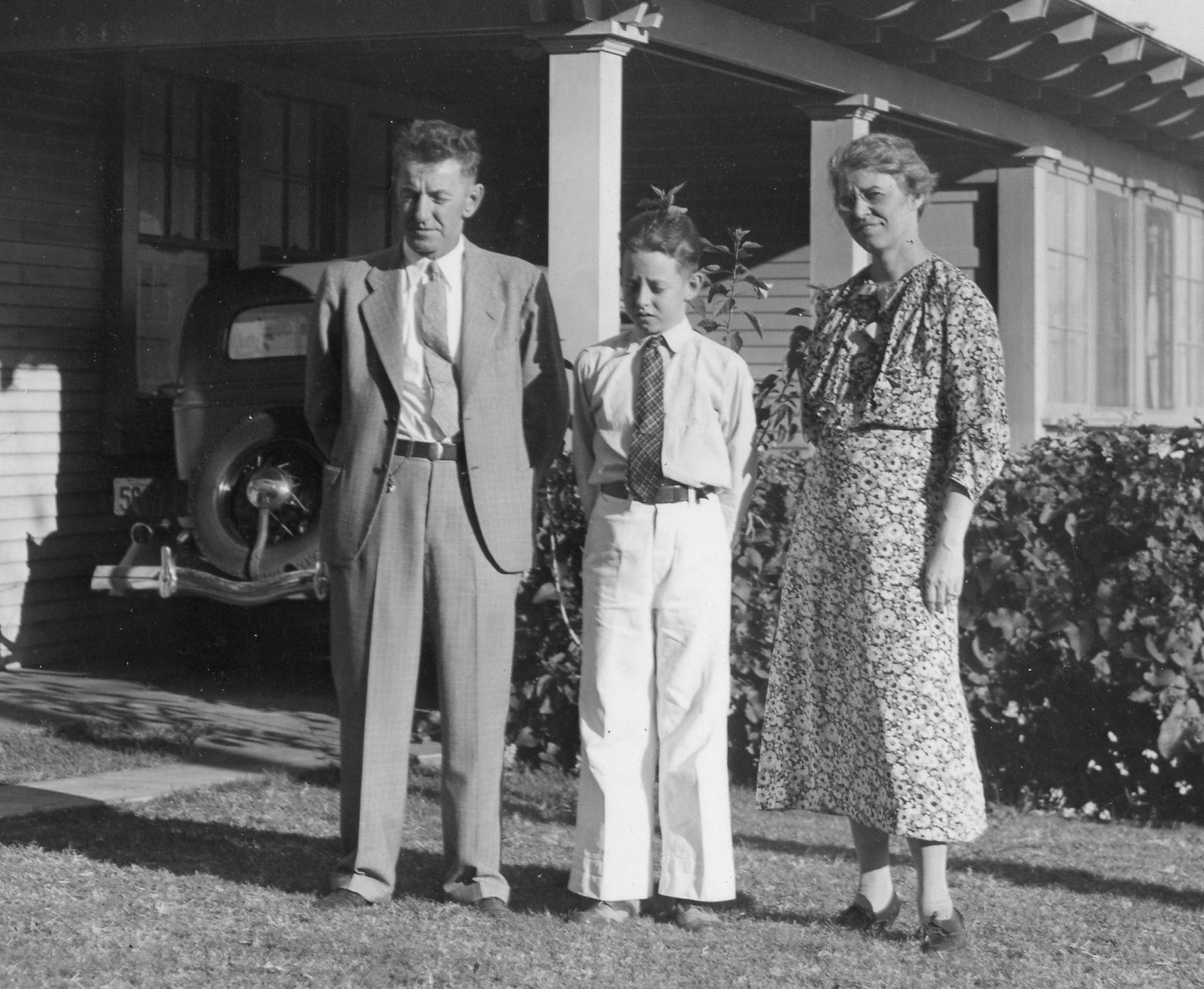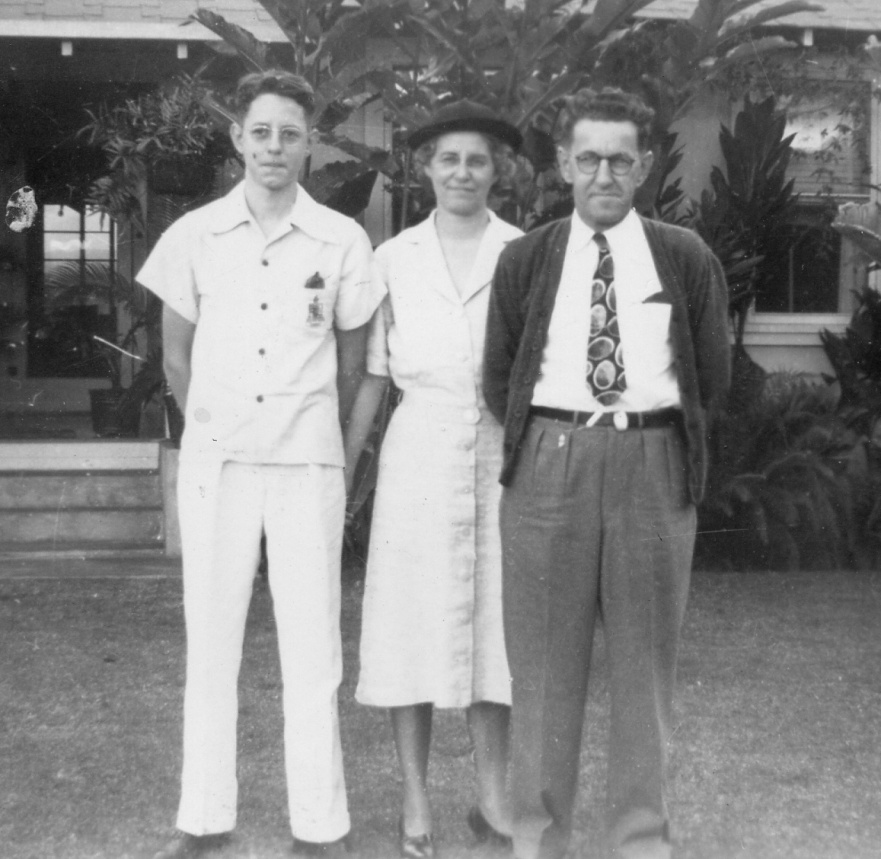|
James F. Clark, Sr. (1889-1942)by Michael S. Clark, grandson
Most of what we know about our grandfather's early years comes from "family stories" told to us by our father James F. Clark, Jr (1924-1999), who was our grandfather's only child. Dad told us that his father became an orphan when he was about six-years old, and that he then ran away from home around the age of twelve. Again, we cannot confirm these stories. The first official mention of any sort that we have for our grandfather is when he enlisted on Dec. 5, 1916 at age 27 in the U.S. Army, a date we know from his army discharge papers. Much of his life before then is a mystery. Another story that Dad heard from his father, and then years later told to us, is that one of our ancestors is a British soldier, who was sent in the 1800s to Ireland. There he met an Irish girl, whom he eventually married. Unfortunately, we never heard when, nor where they married. They then came to the U.S. to settle in Detroit, where they died when our grandfather was a boy. Although Dad seems to have assumed, or at least implied, that this soldier and his Irish wife were the parents of his father, they may actually be his grandparents. Alas, we cannot confirm any of this. Because Dad was just 18-years old in 1942 when he lost both of his parents, many years went by before he could tell these stories to us. He readily confessed that he did not remember much about his father's early life, and he admitted that what he did remember, may not have been entirely accurate. Family stories like these were all that we knew for many years about our grandfather's origins. However, modern genetic testing, along with with the proliferation of genealogic databases available on the internet, allows us to correct some misconceptions, and perhaps get a better picture of what may have actually happened all those years ago. What follows below is our grandfather's story as we now perceive it. Early Years - We know of two documents that provide the names of our grandfather's parents. One of these is his 1923 marriage certificate, wherein he gives the names of his parents as James Frederick Clark, and Carrie Finnegan. Another document with his parent's names is the Michigan Census of WWI Veterans of 1917-1919, which was compiled in 1923 by the Daughters of the American Revolution (DAR). The census data was collected from questionaires that DAR mailed out to the last known address recorded in military records for each Michigan veteran. A transcript of the return for grandfather confirms that James is the name of his father, but it shows a woman named Madge, not Carrie, as our grandfather's mother. Two home addresses appear in our grandfather's military records, and the DAR in 1923 could have sent questionnaires to one or both. The first address is at 62-32nd Street in Detroit, which appears in army records from 1916 to 1920. Although the army shows this as the residence of a cousin named Amos Lemons, the house was actually owned by, and was the legal residence from c.1881 to c.1911 of one John Lewandowski / Lewandofske (1851-1936). The second address is one in Windsor, Canada, just across the river from Detroit, and it appears from 1920 on in the army records, as the residence of a family friend named Mrs. Belle Groh. Although the DAR may have sent a questionnaire to our grandfather's relative at the Detroit address, it is much more likely that questionnaire was sent to his last known address, which means it wouild have been sent to Mrs. Groh in Windsor, Canada. There is also the modern DNA evidence that we alluded to earlier. Autosomal DNA data of our grandfather's descendants shows that he has little if any Irish or Scottish ancestry (i.e., his ethnicity). Instead his genetic ethnicity is mainly English/Germanic and East European. When we closely study the Eastern Europe portion of the DNA data, it shows that our grandfather is almost certainly the grandson of a German-Polish shoemaker named Johann Lewandowski (1814-1889), who immigrated in the early 1880s from the German province of West Prussia, and settled in Detroit. West Prussia today is part of Poland. We suspect that the aforementioned mother named Madge is our grandfather's biologic mother, and that Irish-born Carrie Finnegan is a stepmother, who raised our grandfather after Madge died. Given that the aforementioned John Lewandowski of 32nd Street is a son of Johann Lewandowski the shoemaker, this means that Madge is probably an unconfirmed daughter of his Johann, the German-Polish shoemaker. If Madge died in childbirth, or soon after, than the Irish stepmother who raised our grandfather may have been the woman whom he idenifies on documents as his mother. The Y-DNA data of our grandfather's male descendants provides some additional insights. Their Y-DNA shows conclusively that the origin of our grandfather's paternal line, and therefore his Clark surname, is definitely not Irish nor Scottish. Instead, it shows that his male line line from central Europe. In other words, their Y-DNA is not "Gaelic" but "Alpine". If his father was indeed born in Scotland, which is probably correct, then he most likely had paternal English ancestry, perhaps Gallo-Norman, with his male Clark ancestors originating in the distant past from either France, Austria, Switzerland or southern Germany. Circumstantial evidence has led us a man named Frederick James Clark, who was born in 1863 in Edinburgh, Scotland. Interestingly, his father was a bootmaker, of British ancestry, who had been born in southern England. Bootmakers were needed at the time by the British Army, and an interestingly possibility, but one for which we have no real evidence, is that he may have pursued his trade in some capacity for the British Army in Ireland. Irregardless, he met a woman, who was born in Ireland, but whose ancestry could be either Irish or British. They married in Scotland, and moved for a time back to the bootmaker's home in southern England. Here one daughter was born to them, and later another daughter was born in London. They then returned to Scotland, where Frederick James Clark was born, along with four younger siblings. Scottish census returns confirm that young Frederick grew up working in his father's boot and shoe shop, at least until 1881, when the entire family immigrated to the midwestern U.S. It is completely unproven, but the remarkable coincidences make it possible that Frederick James Clark of Edinburgh is the father of our grandfather James Frederick Clark, Sr. If Frederick James Clark of Edinburgh is indeed the man we seek, then we need to place him in Detroit around the time of our grandfather's birth, but alas his whereabouts in the U.S. from late 1888 to 1895 have so far alluded us. DNA has the potential to either prove or disprove this wild theory, but the databases that we can compare our DNA results against are inadequate at this point to provide a conclusive answer one way or another. Most European immigrants of the late 1800s who arrived in the United States came with hopes of finding better lives, but many found found life in America to be little better than what they left behind. Our family stories relate that our grandfather's parents died in Detroit, not long after the birth of their children. We were told that three children were born in Detroit - an older sister, our grandfather James, and a sickly younger brother, who died young. However, we cannot discount the possibility that James was actually an only child, and that these other children were not his true siblings, but cousins, half siblings, and/or family friends. He recalled being only 5 or 6 years old when both of his parents died, so his memories of them were probably faint. He is said to have learned a little Gaelic from one of them, but this seems a bit far fetched. His childhood memories supposedly also included doing the Scottish Sword Dance and/or Highland Fling with his father. Unfortunately, we know nothing more about his life with his parents. We have already mentioned that we know of no records in the Michigan State Archives to confirm his birth date and birth place. This means that May 14, 1889 may not be his correct birthday, and/or he may have been born some place other than Detroit - perhaps in Windsor, Canada, which is just across the river from Detroit. Irregardless, he was probably born at home, most likely with the help of a midwife or relative, rather than a doctor, and even though births in Detroit and Windsor were supposed to be reported, many were not - especially births to immigrant parents. In fact, it is estimated that from 1880 to 1902 only 60% to 70% of the births in Michigan were duly recorded. Furthermore, we have found at least three other men also named James Clark or James Clarke who were also born on May 14, 1889 in the U.S. One of them even lived for a time in Michigan, another had the same middle initial F. as our grandfather, and at least one of them, like our grandfather, also served during WWI in the U.S. Army. This is in addition to many other James Frederick Clarks who were born in the late 1800s in the United States and Canada. We do not know where in Detroit James and his parents lived. Because he was fluent in German, he may have spent some of his childhood in a home where German was spoken, but he may have also picked up his German fluency during WWI, when he served as an interpreter for the U.S. Army. He was was also fluent in Yiddish, which is a German dialect spoken in Detroit by some of the Jewish communities from Europe. Detroit in those days was a city of over 250,000 people, with both a large Jewish population, and a large population of German immigrants. James said that he learned Yiddish by growing up on the city streets with Jewish playmates. This implies that he spent part of his youth on or near Hastings Street, which was the heart in those days of the Jewish district of Detroit. However, there were Yiddish speakers in other parts of the city as well.
When James was about 5 or 6 years old, possibly around 1894 or 1895, he became an orphan, and was sent to live with a German family. Because he was fluent as an adult in German, it seems likely that German was spoken in his new home. We do not know the names of his foster parents, but he gave to the U.S. Army in 1918 the name of a cousin, Amos Lemmons of Detroit, and then in early 1920 the name of a family friend, Mrs. Belle Groh (neé Edgeworth) of Windsor, Canada, as his next of kin. Either one of these people may have been associated with his foster family. The address that he provided for Amos Lemmons is 62-32nd Street in Detroit, which was in District 16 on the west side of the city. This address during the years James lived in Detroit (i.e., 1889 to about 1901) was also the home of John Lewandofske (Lewandowski), to whom James is linked by DNA evidence. Interestingly, the 1901 Detroit City directory lists at this same address an August A. Lemon, who might be a relative of, or maybe is the same man as, Amos Lemmons. The last year that James definitely lived in Detroit was probably 1901 or 1902, which makes it quite possible that his foster parents were members of the Lewandowski family, either in this household, or in that of a Lewandowski relative. In fact, we strongly suspect that James' foster parents were his biologic uncle and aunt, William and Anna Lewandowski - William being a brother of the aforementioned John Lewandofske of 32nd Street. 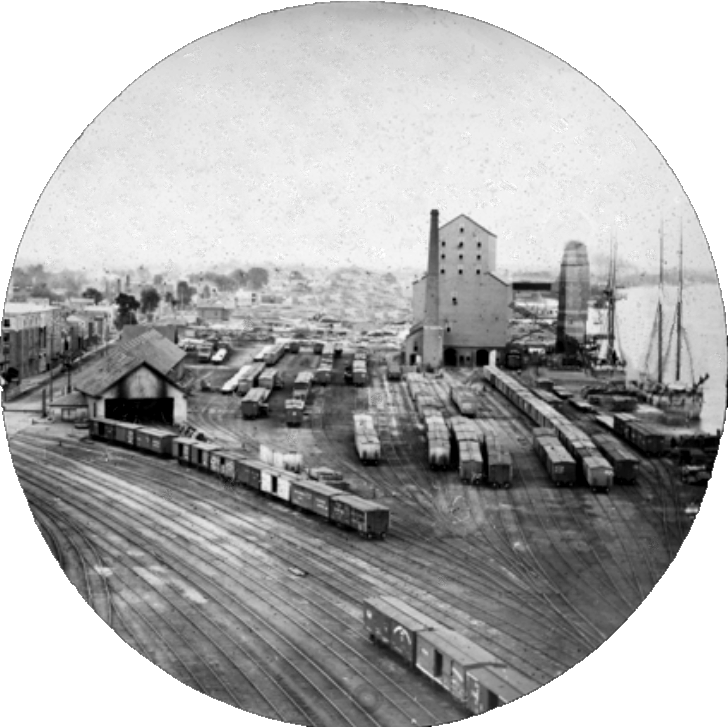
Another family story that we used to hear is that James had either a grown step-brother or foster brother, who had spent time in the "Old West", and would came back to Detroit from time to time for a visit. Once Dad implied that this person may have been in Detroit to hide out from the law. Irregardless, someone in this household, perhaps the brother, perhaps someone else, was apparently a violent person, who made life miserable for James. Once when James was home, and sitting at the top of the stairs, his nemesis came home in a drunken rage and kicked James down the stairs. The fall caused James to either break or dislocate his shoulder or collar bone, resulting in an injury that gave him trouble for the rest of his life. Again, these are just stories that came down to us second hand, and they may or may not be accurate. We strongly suspect now that the so-called older brother was actually a kind man named Gus Holden, who was the brother-in-law of James' foster father, and that it may have been the foster father himself who kicked James down the stairs. When James was perhaps 8-, 9- or 10-years old, his foster father sent him to work in the Detroit train yards, which are shown in the photo on the left. There he worked as a rail car brakeman, which was a very dangerous job for an adult, and much more so for a youngster. The brakes were applied from the back of the train to the front, one car at a time, by turning an upright wheel on the back side of the roof of each car. The brakeman, after setting the brakes, would then run across the top of the moving car, jumping over it to the next one to apply the brakes there in the same fashion. And then so on and so forth, from back to front, until the train slowly lurched to a stop. Falling off a car, or worse yet between two cars, usually meant a serious injury or death. Later, James also worked as a railroad clerk, but possibly not until much later on when he was an adult. Although railroad work was hard, with long hours in all types of weather, James was still able to make friends in train yards all across the Midwest. Unhappy at home, he sought the help of these friends, to run away from home. Although he was supposed to turn over whatever wages he earned to his foster father, he hid enough money for two five-dollar gold pieces, which was quite a bit in those days, and used this money to finance his escape. Then, when the time was right, he caught a train out of the city. To hide his tracks, so to speak, he rode this train for a short distance in one direction, then changed to another train heading in a different direction. By doing this several times, with several trains going in different directions to different places, and with friends pre-arranged at each stop to smuggle him onto the next train, he made it all but impossible for his foster father to follow him. Thus, he left Detroit in this fashion, and did not return home until nearly twenty years later. We know little about those early years of our grandfather's life after he left Detroit. Although he may have worked many jobs in many places, he ended up working at some point on combine (harvester) crews harvesting wheat fields in the Midwest. We suspect that it was during a possible visit to Sheridan, Wyoming, where his kindly maternal uncle Gus Holden made his home, that James decided to leave his railroad job to work with the combine crews. However, this is speculation. Irregardless, the combines would start up in the South in the Spring, then work their way north, harvesting wheat all the way up into Canada. The crews would then turn around, and work their way back south again, so that by the time the weather had changed in the Fall, they would be back to where they started. Staying one step ahead of winter, the combine crews eventually ended up in New Orleans where the workers were paid the entire season’s wages in full. Thus, for the first time in many months, James and his companions found themselves with idle time on their hands, and money in their pockets. A few nights of drunken revelry were usually in order; and the men afterwards, carrying with them everything they owned, would look for winter quarters to wait out the season until the combines returned in the spring. One night in New Orleans, having just received his season wages, James was out on the town when he was robbed of everything he owned, but the clothes on his back. The term our Dad used was that his father was "rolled". Penniless, with no place to go, and no one to turn to, James had few options. Rather than sleep in the streets, he enlisted on Dec. 5, 1916 at the age of 27 in the U.S. Army, and the army became his new home. He was assigned to the 28th Infantry stationed at Jackson Barracks in New Orleans, where he said that "life was good", as he received clothes, room and board, and six dollars a month in pay. Army life was probably somewhat similar to the communal life of the combine crews, which meant James probably had little trouble adjusting. The year 1916, when James enlisted, was a time of turmoil. Europe was overcome by a long, drawn-out war that embroiled most of the continent, and the United States was facing the prospect of a war with Mexico. General Venustiano Carranza, having just seized power in Mexico, was threatened by the rebel bands of his adversary Pancho Villa. When the U.S. President Woodrow Wilson gave formal recognition to Carranza’s government, Villa was enraged, and vowed to seek revenge against U.S. towns sitting north the Mexican border. Villa on March 16 crossed the border from Mexico into the U.S with his "banditos", burning the town of Columbus, New Mexico, and killing sixteen men, women and children. President Wilson lodged an immediate protest with Carranza, but the Mexican general did little to allay American fears. Because further raids seemed likely, Wilson sent in American troops the next day under the command of General John J. Pershing to pursue Villa into Mexico. Carranza condemned Pershing's pursuit as an invasion, and threatened war. So when James enlisted in the army in December of 1916, the U.S. was already massing troops in Texas and New Mexico, and James' regiment was soon dispatced to secure the Mexican border, and prepare for a possible American invasion of Mexico.
The Military Record of James F. Clark, Sr.(serial number R-56613)
Dec. 5, 1916 - Enlisted in Company A of the 28th Army Infantry at Jackson Barracks in Louisiana for $6.00/month plus clothes, room, and board. At the time, American troops under the command of General John J. Pershing, were pursuing the Mexican revolutionary Pancho Villa deep into Mexico. Eventually, the 28th was sent to Texas in support of the pursuit. However, the 28th remained on the American side of the border and never made the crossing into Mexico. Feb. 5, 1917 - United States troops are recalled back across the border in order to avoid an open conflict with Mexico, but border skirmishes continue for the next several months. In one incident, Private Jim Clark entered a shack near the border and was attacked by a bandito swinging a machete. Holding up his rifle to protect himself, he deflected the blow; but the unprotected fingers of Jim’s left hand, holding tightly onto the stock of his gun, caught the full force of the blade. Portions of his first and second finger tips were cut off just below the fingernails before Jim bayoneted his adversary to the wall. It states on the back of his 1942 WWII Draft Registration Card that the "first joint of index and second finger of right hand missing." April 6, 1917 - War is declared against Germany; and the Mexican campaign, in light of the greater conflict, is quickly forgotten. Curiously, this date is shown in the Veterans Administration Master Card Index as the date for Jim's enlistment into the U.S. Army. However, he actually enlisted four months earlier, the earlier enlistment date being confirmed in other records.
May 29, 1917 - Promoted to Corporal at Fort Ringgold in Texas. June 14, 1917 - The 28th Infantry sails for Europe from the port of Hoboken, New Jersey with the 196 men and two officers of Company A on the S.S. Antilles. Capt. Francis Henry Burr (1881-1960) is in command of the company. The departure was originally scheduled for June 7, but there were many delays. Nonetheless the S.S. Antilles, which previously had been a commercial passenger liner, is among the first ships to leave. The 28th is one of the four infantry regiments (the 16th, 18th, 26th, and 28th) of the 1st Division of the American Expeditionary Force (A.E.F.). Fifteen days later the A.E.F. lands at Brest in northern France, and the soldiers of the 1st Division become the first American troops to enter the war. A few months later the S.S. Antilles is sunk on Oct. 17, 1917 by German submarine U-62.
Aug. 1, 1917 - Rank reverted to Private 1st Class. It is not known if this represents an expiration of a temporary promotion to corporal, or if it was a demotion resulting from some sort of disciplinary action. Because there is no mention of any diciplinary action in his military records, and because his military record in fact states that his character was excellent, it is quite possible that this promotion was never intended to be permanent, and that Jim may have been made a corporal by the 28th Infantry just for the voyage to France. If so, the warrant (contract) for this rank was never intended to extend, and indeed did not extend, when the voyage concluded, and the 28th was assigned to new duties on arriving in France. The French and British commanders were anxious to send the untested, green American troops into the trenches to fill the gaps in their own war-weary ranks. However, Pershing had no desire to engage his command in the war of stalemate and attrition that the Allied and Axis powers had waged for three long years. Instead, the Americans were assigned to quiet defensive sectors to gain experience while Pershing worked on developing an offensive strategy. Far removed from the fighting at the front, the men of the A.E.F. were at their leisure to enjoy the French countryside and learn French lifestyles and customs. One day, some of the officers of the 28th decided that, as a gesture of goodwill towards the locals, the Americans would haul away a number of large, foul-smelling manure piles that graced the front yards of several houses in a nearby farm village. Early one morning, the deed was done. However, when the farmers awoke and discovered what the Americans had done, the intended good deed was viewed as something more akin to an act of war. Apparently, the manure was fertilizer for the village fields, and the town elders demanded the immediate return of the piles. The soldiers quickly hauled the offending piles back into town, thereby avoiding conflict with the French peasantry.
Oct. 20 to Nov. 20, 1917 - Lunneville Defensive Sector, a minor defensive operation. Jan. 15 to April 3, 1918 - Toul Defensive Sector, a minor defensive operation. April 25, 1918 - Montidider-Noyen Offensive begins, a major offensive operation, lasting until July 7 and fought alongside French and British troops. This operation involved several battles and was the first time that American troops were engaged in actual combat.
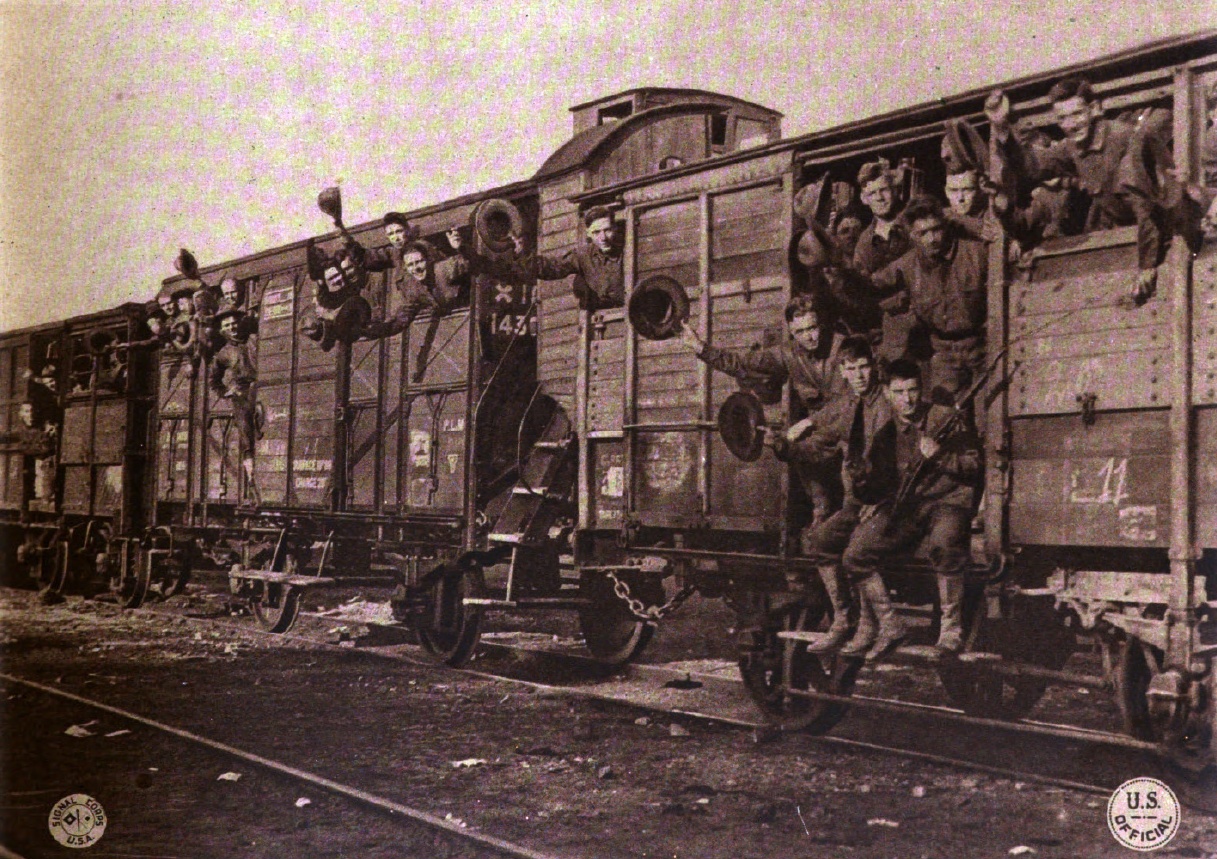
On the eve of being shipped to the front, the men of the 28th were given passes for the evening. Virtually all of the troops headed into town for some serious drinking - possibly the last party that many of them would ever know. When the time came to return to camp and board the trains for the front, most of the 28th was still in town, drinking up a storm and hoping to delay the trip to the trenches for as long as possible. Jim and a friend or two staggered back into camp at the appointed hour, drunk and happy. Despite their condition, they were given the task of helping to round up drunken comrades and place them on a train for the front. The gathering of the 28th proved to be a difficult task. As soon as a partying soldier was caught and thrown on the train, another would slip out the nearest window and head back into town. After a few soldiers had been apprehended several times, the officers finally figured out what was happening and posted an armed guard to watch the train windows. Thus, with fixed bayonets blocking the avenues of escape, the men of the 28th were rounded up, thrown into trains, and shipped to the front. The soldiers of the 28th had good reason to fear the front. The dampness and disease of the trenches were legend, and when these discomforts were combined with the technological horrors of modern warfare, utilized in battle for the first time in history, the Great War became truly one of the most terrifying episodes in the human experience. Fighting machines - including tanks, armored cars, and airplanes - appeared in battle for the first time; and technologically-advanced weapons - such as machine guns, flame-throwers, and poison gas - added new dimensions of terror unknown in previous wars. Wary of facing death at the hands of so many new forms of destruction, both sides opted for a defensive war. Miles and miles of trenches, from within which to hide, were dug across the French and Belgian countryside. In grim irony, the trenches merely became focusing points for the terrors of the Great War; and the dampness, disease, starvation, poison gas attacks, endless artillery bombardments, and brutal hand-to-hand combat of the trenches were magnified when combined with the terror of fighting machines and mechanized weapons. Once, Jim was issued a hand ax and advised that this tool was one of the better weapons for hand to hand combat in the close quarters of a trench. Meat cleavers, sharpened trenching shovels, and small pick axes were also weapons of choice. Apparently, the standard 24” American bayonet was much too long to swing around in the narrow confines of a trench; and European bayonets, at 30” to 36”, were said to be even worse. After four years in the trenches, the war-weary ranks of both sides were growing thin. Fresh troops were in short supply, and men of all ages were pressed into service. Jim remembered one instance when, after an especially bloody and brutal trench fight, he noticed that the dead German soldiers he had helped to kill were mostly 14 and 15 year old boys whose “rifles were bigger than they were”.
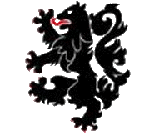
May 28 to 30, 1918 - The Battle of Cantigny was the first all-American offensive in the war and was fought with French and British support. The battle began on the morning of May 28 with an hour-long artillery bombardment, followed at 6:45 a.m. by the American advance, which crossed a front of 2,200 yards in 45 minutes to reach the German trenches. Although Cantigny was an American victory, with close to 250 German prisoners taken, the Americans by one account lost 45 officers and 1,022 men. Another account states that there were 1,603 American casualties, with 318 deaths. Despite fierce counter attacks over the next three days, the Germans were unable to retake the captured positions. Shown to the right are the Coat of Arms adopted by the 28th Infantry after WWI, when they were nicknamed the "Black Lions of Cantigny", in recognition of their sacrifice.
Jim was wounded at Cantigny during the American charge on the first day of battle, and though he lived to fight again, he was left emotionally and physically scarred for life. His unit on the morning of the 28th was given orders to storm the enemy positions after an artillery bombardment had hopefully weakened the German positions. The Americans issued forth from their trenches at the appointed time, and began the long charge across the crater-pocked expanse of “no-man’s land” to engage the enemy. Running through a smoke-obscured hail of bullets and shrapnel, with shells exploding all around, Jim saw the head of his best friend blown off in an explosion, and yet the headless body, bloody and torn, continued to run until it disappeared into the smoky mists. Shrapnel from another explosion tore off part of the heal from Jim’s foot, and, unable to run any further, he stumbled into the crater of a shell hole, where he sought refuge with two companions. The artillery bombardment continued, and the Germans, in an attempt to stem the American advance, released clouds of deadly mustard gas. The dense fumes settled into the low spots of no-man’s land, and the shell holes in the battlefield became gas-filled death traps. Jim, dazed from his heel wound, was unable to get his gas mask on by himself. He later told his son that he would have coughed his lungs out and died had he been by himself, but one of his companions helped him on with his mask just in the nick of time. The battle continued, and the artillery barrage never let up the entire time. The recent memory of a friend’s horrible death, the ceaseless pounding of the big guns, and the loss of blood eventually took their toll. When medical help finally arrived, Jim had succumbed to "shell shock", a type of post-traumatic stress syndrome (PTSD) that Wikipedia describes as, "a reaction to the intensity of the bombardment and fighting that produced a helplessness appearing variously as panic and being scared, flight, or an inability to reason, sleep, walk or talk". Wounded, gassed and shell-shocked, Jim was sent to the rear to recover in a field hospital. The head medical officer, regimental surgeon Major Clarence E. Fronk, [1] nursed Jim back to health. Many years later, after Fronk had become a close family friend, Fronk often joked that in order to repair Jim’s wound he had “to graft a dog bone onto his heel”. The U.S. Army on July 1, 1918 acknowledged that Private James F. Clark was severely wounded in action in an announcement of casualties that was made in the "Official Bulletin of Casualties Reported by Gen. Pershing" (U.S. Committee of Public Safety, v. 2, p. 7). This announcement lists "Amos Lemmons of 62 Thirty-second Street, Detroit, Michigan" as next-of-kin. The name Amos Lemmons surfaces once again in Jim's army records more than a year later in transport papers dated June 15, 1919, wherein Amos Lemmons is listed as a cousin. Unfortunately we know nothing further of Amos Lemmons, nor what became of him. Jim remained in the rear, out of action, for a short time during the summer of 1918. During this time, he sat out the main engagement of the Mondidier-Noyon offensive from June 9-13. For this reason, he may not have qualified for a Mondidier-Noyon battle clasp, despite having been wounded at the Battle of Cantigny. He also missed the battles of Soissons, Saizerais and Vancoulers, which were part of the Aisne-Marne offensive of July 18 to August 6. His wounds apparently had healed shortly after the latter offensive, as he was back by September with the 1st Division at the front.
Sept. 12 to 16, 1918 - The Battle of St. Mihiel was the first offensive fought by the Americans without the support of French or British troops. The Americans attacked the St. Mihiel Salient, 20 miles southeast of Verdun, during an evacuation of the German troops. The Americans cut off the retreating Germans on the first day of battle and took over 16,000 German prisoners at a cost of fewer than 7,500 American lives. Sept 29 to Oct. 10, 1918 - The Battle of the Meuse-Argonne Forest followed the St. Mihiel victory and was a major offensive fought by combined French and American forces. The battle resulted in the final breakdown of German resistance and led to the final surrender of Germany. A second Meuse-Argonne operation took place Oct. 25 to Nov. 11, but Jim Clark had been transferred out of the infantry by this time and did not participate. 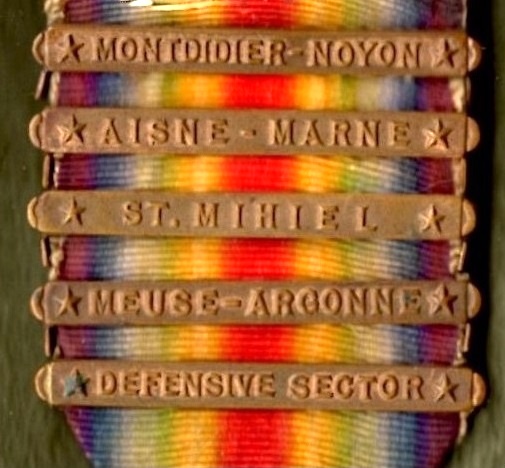
Oct. 18, 1918 - Transferred to the medical department as a consequence of his wounds, which resulted in Jim finishing out the war behind American lines. The unit he was assigned to was probably "Evacuation Hospital No. 9", as this is the unit he was with when he came home to the U.S. after the war had ended.
Nov. 11, 1918 - Armistice Day - Germany surrenders and the Great War comes to an end. Dec. 15, 1918 to May 20, 1919 - Assigned to the Army of Occupation in Germany. Since Jim had grown up in a German-Jew neighborhood in Detroit, he spoke Yiddish, which is a dialect spoken by German Jews. He also may have lived as a child in a home in which regular German was spoken. Irregardless, he was fluent in both German and Yiddish, which led to his being being stationed after the war with the Army of Occupation in Germany as a military interpreter. He remembered this duty as “the good life”, since responsibilities were few, life was easy, and there was always plenty of food. We were given a photograph Jim's old unit of Company A, 28th Infantry from when it was stationed after the war with the Army of Occupation in Dernbach, Germany, but Jim is missing in the photograph, as he was working as a German interpreter by then with Evacuation Hospital No. 9. April 21, 1919 - Promoted to Corporal by Company A, 28th Infantry. This represents the second time that Jim was promoted to the rank of Corporal by the 28th Infantry, having previously served from May 29 to Aug. 1, 1917 before, during and just after the 28th sailed to France with the U.S. entry into WWI. Thus, this second promotion represents a reinstatement of Jim by his old unit to his previous rank. June 15, 1919 - Sailed from St Nazaire, France on a military transport ship named the S.S. Texan and arrived on June 27, 1919 at the harbor of Newport News, Virginia. His unit is listed on his transport papers as Evacuation Hospital No. 9, with his rank as Corporal M.D. He listed his next-of-kin on these papers as a cousin named Mr. Amos Lemmons at 62 Thirty-second Street in Detroit, Michigan. Lemmons was previously named as next-of-kin on July 1, 1918 when the army announced that Jim had been wounded in battle. Although we have these two mentions of Amos Lemmons, he does not appear by that name in the Detroit City Directories, and we have found no mention of him in any of the U.S. or Canadian census returns for the Detroit-Windsor area. However, the 1901 Detroit City Directory does show an August A. Lemon living at 62 - 32nd St in the home of John Levandofske (Lewandowski), and we suspect that this August A. Lemon and Amos Lemmons are the same person.
Jim’s "older sister", who may have actually been a family friend and not a relative, is said to have lived in Canada. He wrote to her regularly, and sent her his paychecks, with the understanding that she would safeguard his earnings. Thus, if Jim survived the war he would have a "grub stake" with which to start life anew, but if he did not survive, then his money would be hers to keep. When Jim finished his tour of duty in Germany, he took an extended leave of absence to return home to Detroit so that he could visit family and friends, and reclaim the savings that he had placed in the care of his sister. So Jim, after being away for 18 or more years, finally came home. He likely tried to visit his cousin, and next-of-kin, Amos Lemmons, who Jim remembered as living at the home of John Levandofske at 62 - 32nd St. However, Jim probably had no way of knowing that by 1919 the Levandofske family no longer lived there. Thus, he may have lost contact with Lemmons. In addition, many of Levandofske's family had passed away by then, and Jim may not have been able to find, or perhaps had little interest in finding, those still living. Jim of course went to visit his sister, who lived across the border in Canada, most likely in the town of Windsor. However, when he called on her, she was cold and unfriendly, and the money he had sent her was gone. So he returned to the U.S., and never wrote her, nor saw her ever again. We strongly suspect that this "older sister" was actually Mrs. Belle Groh, of whom we have more to tell later. Once again without money, home or family, Jim turned to the army.
Dec. 5, 1919 - Re-enlisted at Fort Sheridan in Illinois for another three years. Jim as a re-enlisting veteran had his choice of assignments, and he chose Hawaii. Jan. 28, 1920 - The U.S. Census shows James F. Clark at Angel Island in San Francisco Bay near Marin, California with several other soldiers, presumably in transit to Hawaii. Feb. 5, 1920 - Sailed from San Francisco Harbor on a military transport ship named the S.S. Logan and arrived on Feb. 15, 1920 at Honolulu Harbor in the Territory of Hawaii. He listed his next-of-kin on his departure papers as a friend named Mrs. Belle Groh (neé Isabella Edgeworth) at 39 McKay Avenue in Windsor, Canada, which is located just a short distance away on the other side of the river from the Detroit address he previously listed for his cousin Amos Lemmons. The fact that he listed her and not Amos, indicates that Amos may no longer have been around, or that Jim for whatever reason was no longer in contact with Amos.
Nov. 5, 1921 - Promoted to sergeant at Fort Shafter in Honolulu, Hawaii. Later, Jim was stationed at Tripler General Hospital where he worked as a medical orderly. His commanding officer at Tripler was Colonel Clarence Fronk, the same Dr. Fronk who had nursed him back to health in France three years earlier in the aftermath of Cantigny.
Jim intended to make the army his career, but in Honolulu he met and fell in love with Louise de Harne. He asked her to marry him, but Louise refused to marry a soldier. She gave Jim the choice between her and the army. He chose Louise, and when his tour of duty ended he left the army to become a civilian again.
Dec. 4, 1922 - Discharged from Tripler General Hospital in Honolulu, Hawaii and mustered out of the U.S. Army. His discharge papers give his height as 5 feet 7½ inches tall, his eye color as blue, and his hair color as light brown. His commanding officer at Tripler also included with Jim's discharge papers a handwritten letter of recommendation stating that Jim was, "a reliable, sober, industrious and trustworthy man and deserving of a good position." 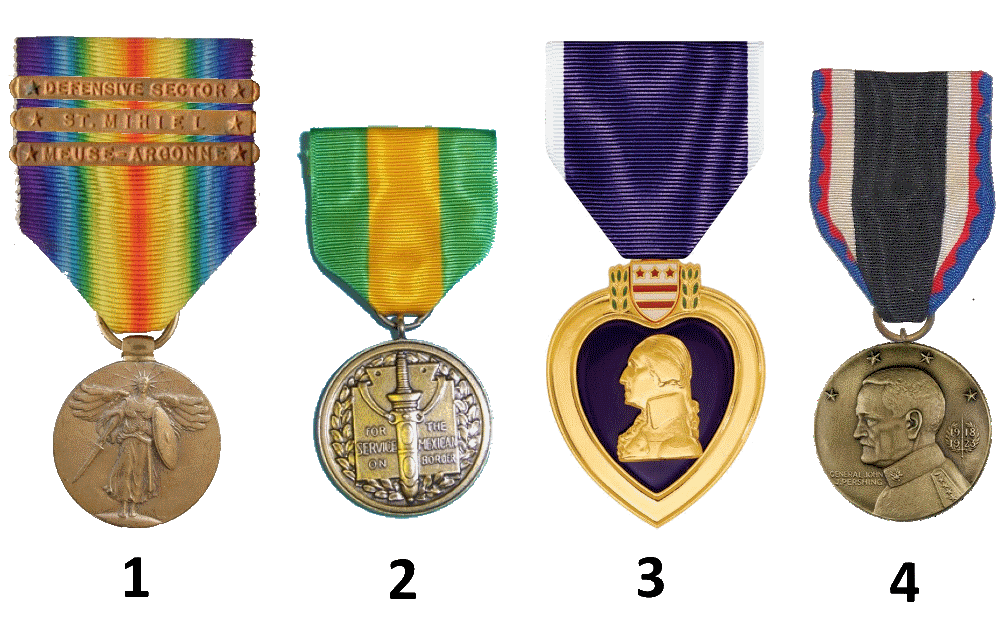
Jim was mustered out of the military with one official war medal: 1 — Victory Medal with three battle clasps (Defensive Sector, St. Mihiel, and Meuse-Argonne) Other medals that he could have received, had he or his son applied for them, were: 2 — Mexican Border Service (created July 9, 1918) 3 — Purple Heart (revived February 22, 1932) 4 — Army of Occupation of Germany (created November 21, 1941)
He was introduced to his future wife Louise de Harne by an old army friend named Joe Walsh, who was in the Army Medical Department with Jim. Joe was destined to become Jim's future brother-in-law. I believe that the event where the introduction took place was a dance of some sort that was put on to help soldiers meet unmarried women, but I may or may not not remember the facts of the story correctly. In any event, Jim and Louise fell in love, and they were married by Reverend Father Theodose on Wednesday, Oct. 9, 1923 at the Sacred Heart Catholic Church on 1717 Wilder Avenue in Honolulu (Punahou). He was 34, and she was 31 years old. Louise's silbings Alice and Edward de Harne were witnesses. Jim and Louise went to live with Louise's mother Frances de Harne in a large house at 1245 Wilder Avenue, which was just a short distance from the church where they were married. They also lived briefly in apartment no. 4 at 1268 Young Street, but this was probably right after they were married, and they may not have been able to afford the rent. Besides Jim, Louise and Frances, who was known to everyone as grandma, Louise's siblings Helen, Eleanor and Eddie also lived in the Wilder house. There were at least two bedrooms upstairs in the attic, and Jim and Louise stayed in one of the bedrooms, with Louise's brother Eddie in the other bedroom. This was where Jim and Louise stayed for the next 20 years. 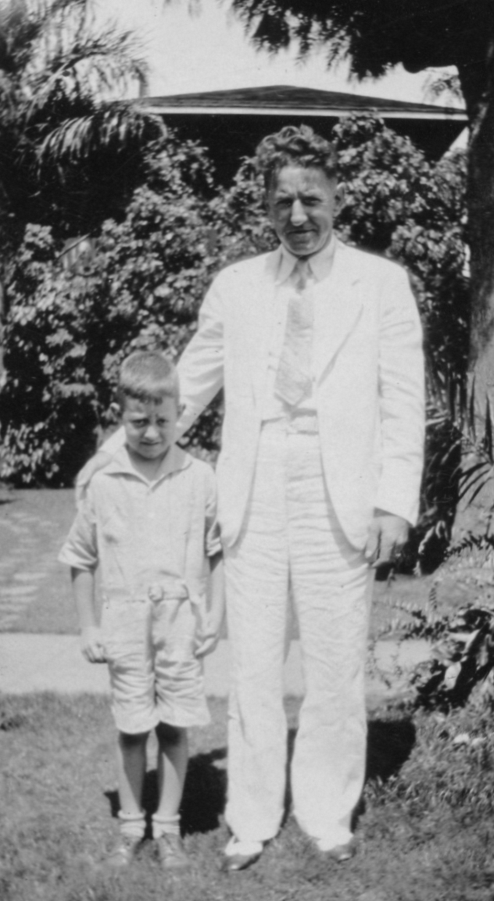
Our father, James Frederick Clark, Jr., was born on Nov. 9, 1924 at the old maternity house on Beretania Street in Honolulu, where he was delivered by Doctor Fronk, his father's army friend from Tripler Hospital. James, Sr. wanted his son to be named Jamie, the Scottish version of his own name, but the registrar incorrectly recorded the name on the birth certificate as James, which is said to have saddened James, Sr. Back home, the rest of the family - his de Harne aunts, uncles, and cousins - called young James either "Jimmy" or "Junior", depending on their mood, even though he hated being called Junior. * * * James, Sr. held many jobs over the years. When he and Louise got married, he was working as a "water boss" (luna) on a pineapple plantation. Later he went to work as a packing foreman for Theo H. Davis & Co., whose founder was a factor (mercantile and colonial agent), and a member of one of the original missionary families in Hawaii. Theo Davies was also one of the "Big Five" sugar companies on the island, but they diversified early on into many different businesses. Although we do not know this certain, Jim probably worked in the dry goods department of the company. We do know that from 1924 to 1928 he is listed in city directories as a clerk for Theo Davies. Unfortunately, Jim had a very bad temper, and he was fired when he got into a fight of some sort at one of the company packing houses. He is next listed in the 1929 Honolulu city directory as a salesman for Mel Nicoll & Co, which was owned by Melvin Adam Nicoll (1889-1935) who had formerly been a manager in the dry goods department of Theo Davies. Mel, like Jim, was very active in Elks Lodge 616, and it seems likely that he and Jim probably worked together at Theo Davies. However, all we know for sure about their relationship is that Jim at one time was one of Nicoll's employees. James, Sr. remained close friends though the years with his former Army Medical Corp commanding officer Colonel Clarence Fronk, whom he first met on the battlefield in France when Fronk had tended to him at an army field hospital. Fronk was not only a valued family friend, but also the family doctor. Fronk was Jewish, as well as a passionate big game hunter who traveled all over the world in search of trophies. Fronk was also fluent in Yiddish, and he and Jim greatly enjoyed conversing with each other in that obscure German dialect. James, Sr. was not a well man, and he had problems with ulcers as a consequence of his war injuries. His friend Colonel Fronk arranged for him to have an ulcer operation at the Navy hospital at Pearl Harbor, even though the Colonel was a former surgeon at Tripler Army Hospital in Honolulu. Apparently, the Navy hospital gave better care than Tripler, and Fronk wanted Jim to have nothing but the best. This was probably in the latter part of 1928, as it was sometime after Jim was fired from the Theo Davies job, and sometime before he went to the Volcano House on Kilauea Volcano for an "extended vacation" to recover from the operation. One of the more interesting jobs that James, Sr. held was when he worked for the National Park Service for about eighteen months at some point following his ulcer operation. Hawaii Volcanoes National Park had been established on ther "Big Island" of Hawaii only 15 years earlier, and Jim worked on various projects from a military camp near Kilauea Volcano within the park. He also helped to explore several lava tubes that were near the camp, and there was at one time an old photograph showing him entering one of these tubes. However, we have not seen that photograph now for many years. An interesting coincidence is that when James, Sr. was exploring lava tubes in the National Park, there was another Jim Clark (James Frankin Clark, 1861-1943) in the area, who was also exploring the tubes. This other Jim Clark, who was born in Toronto, Canada, is referred to in newspaper accounts of the time as "Jim Clark of Honolulu", and he was a foreman for the Honolulu (Lucas) Planing Mill on Kaimuki Street. He was also a good friend of E.H. Edwards, who owned the Waiohino Ranch on the southern tip of the Big Island. The "Clark Cave" near Waiohino is a lava tube that is named after this other Jim Clark. When he was in the area exploring lava tubes, he generally stayed at the Volcano House, a hotel concession near Kilauea Volcano in the National Park. Interestingly, both Jim Clarks actually stayed at the Volcano House in 1928 - James Franklin Clark was there in April of that year, and James Frederick Clark was there in December. Our Jim Clark, who the papers identify as James F. Clark, also spent 10 weeks starting in December of 1928 staying at the Volcano House. While there, he helped in building of a 115-room expansion of the facility. Presumably this was before he worked for the park service, but it may also have been after. The Volcano House at the time was owned by the Inter-Island Stream Navigation Company, but it previously was owned by "Uncle George" Lycurkas, who James had worked for in 1923 as a water boss for the Pearl City Fruit Company. Inter-Island Steam operated the hotel as a concession for the National Park Service, but when the concession went bankrupt in 1932, Lycurkas, bought it back. My Dad recalled that his father was a good friend of the Lycurkas family, which makes it possible that his stay at the Volcano House was arranged by "Uncle George" himself. James, Sr. in late 1932 was working as a salesman for a printer shop in Honolulu known as Hawaiian Printers. However, we do not know when he started this job, nor how long he held it. Possibly he took this job after he left the National Park Service, but there may have been other jobs in between.
The Iolani Palace, where the Attorney General’s office was located, was near the main post office of the city, and James, Sr. stopped there often to bring home stamps and cachets for his son Jimmy’s stamp collection, cachets being embossed evelopes commemorating special postal events. Some of these cachets are quite elaborate, and we still have one with signatures on it that James, Sr. collected from both the postmaster and Governor Poindexter. 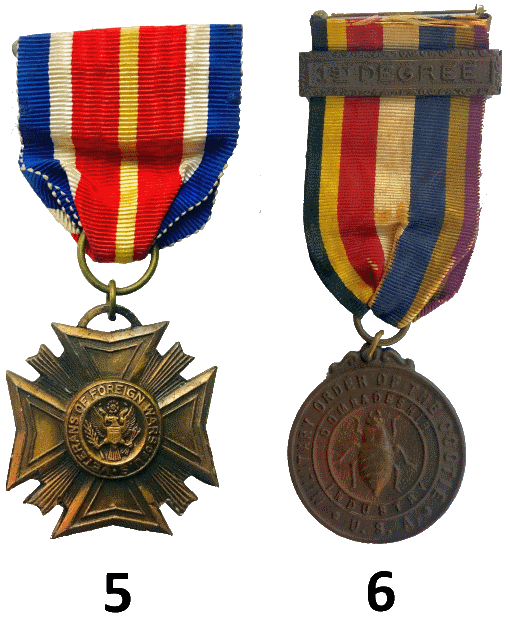
James, Sr. had many interests, foremost of which was his membership in the Elks Club (Benevolent and Protective Order of Elks). He was a very active member of Lodge 616 in Honolulu, which met in a hall in Waikiki, and he proudly wore a pocket watch with an Elk's tooth on it. He was elected in 1932 to the office of Tyler (Inner Guard of the Door) for the Lodge, and we believe that he held this office for several years. He also served the Lodge as chairman of the Milk Fund, which bought and distributed milk to the poor, and he helped out during the Holidays with the distribution of Christmas baskets to the needy. Another organization that he was active in, at least in the 1920s, was the Veterans of Foreign Wars (VFW), whose membership consists of "veterans who, as soldiers, sailors, Marines, Coast Guardsmen and airmen, served the U.S. in wars, campaigns, and expeditions on foreign soil or in hostile waters." In addition to the VFW, he was a member of the Military Order of the Cootie (MOC), which was founded in 1920 by WWI veterans, and then chartered in 1923 by the VFW as a separate and subordinate auxiliary organization that still exists today. Its services include supporting veterans hospitals and the VFW Home for Children. Medals that James, Sr. received from these organizations are shown on the right. James, Sr. was also an avid golfer, and he played on a team in the Honolulu Commercial Golf League. His team was known as the Territorialists, and it was made up of comrades from the Attorney General’s Office. He apparently was one of the leaders of the team, and he coordinated a number of their events. We still have a newspaper clipping that shows a photo of him presenting to Governor Poindexter a golf trophy that the Territorialists had won. We also have a medal that James, Sr. won in golf tournament Religion was important to James, Sr., as it was to his wife's family, and he, Louise and Jimmy regularly attended the Sacred Heart Catholic Church (Punahou) that was located just down the street from their Wilder Avenue home. This was the same church where James and Louise had been married. When the church on Sunday, Oct. 17, 1926 organized a new branch of the Holy Name Society, James was selected as a member of the first advisory board for the branch. Then James on Jan. 1, 1928 was named the branch president, to succeed the founding president Ambrose Wirtz. Another of James' interests was politics, and he was a member of the Democratic Precinct Club, which represented the Democratic Party in his part of the city (16th Precinct, 4th District). Because he was a Democrat, this sometimes put him at odds with other members of the de Harne family, all of whom were Republicans. He served the party at one time as county chairman, and another time as treasuer, and when he took his job as investigator for the Attorney General's Office, it was with the endorsement of the Democratic Pary. His wife's sister Alice apparently did not like him, and his political affiliation may have been part of the reason. James, Sr. was not a big man, and we know from his 1942 WWII draft registration that he was 5'7" tall, 140 pounds, with blue eyes, brown hair, and a ruddy complexion. He had a good tenor voice, and he liked to sing. He also enjoyed gambling, particularly at card games, often playing cribbage and poker at the Elks Lodge, where he is said to have seldom lost. He was also an excellent swimmer, and my Dad recalled that his father often went for afternoon swims in the ocean. The fact that he knew how to swim at all is interesting, given his childhood in the Detroit slums. Because James, Sr. spoke fluent Yiddish, he had many Jewish friends, among them Colonel Fronk. He could also speak German, having grown up in a home where German was spoken, and then later serving as an Army interpreter in Germany during the war. Our Dad used to recount how his father once befriended a German sailor during the depression. Dad had gone with his father to Pearl Harbor to see a German battleship that was docking there. This ship was probably the Emden, which was actually a German light cuiser that had docked at Pearl Harbor in Feb. 1936 during a training mission. If so, Dad was 11-years old at the time. As he and his father walked the dock alongside the ship, they encountered a German sailor in uniform, and Jim Clark, Sr. greeted the sailor in German. Apparently, the German did not speak English, yet he and James Sr. were able to easily converse. Dad had no idea that his father knew any German at all, and he was completely amazed to see his father speaking it fluently. Despite his golf and swimming, which might indicate otherwise, James, Sr. was never a well man, his physical and emotional health having been compromised from when he was wounded, gassed, shell-shocked in WWI at the Battle of Cantigny. He had a bad heart, and suffered several minor heart attacks over the years. Because of this he needed to always carry with him ammonia capsules to revive himself in the event an attack. He also had traumatic ulcers that reacted violently to acidic foods, like tomatoes and pineapples. Yet he loved tomatoes, so from time to time he ate them anyway, which meant that Louise would end up staying with him half the night inducing him to drink hot water and vomit them up. Because his memories of the war never left him, he suffred from severe "post traumatic stress syndrome" (PTSD) that resulted in chronic nightmares, during which he would roam the house at night while in his sleep, reliving the horrors of the war in his dreams, and looking for Germans to kill. During these episodes, Louise would grab little Jimmy from his crib, and the two of them would hide together under the bed until the nightmares were over. During waking hours, loud noises reminded him of past battles, and once, when opening the front door to his house on Wilder Avenue, a dynamite blast two or three blocks away caused him to shake uncontrollably. Another time a string of firecrackers that someone threw behind him caused the same reaction.
Louise was safe, but not well, as she contracted cancer (carcinoma) of the ear in the months following the attack. Despite a trip to the mainland for an operation, her condition steadily worsened, and she died on Oct. 8, 1942, just a few days before her 51st birthday, after a long and painful illness. James, Sr. missed her terribly, and he lived only two months longer than she. He died very suddenly of a heart attack on Dec. 14, 1942 at the age of 53 years. Apparently, he had been swimming the afternoon before without any trauma. However, a heart attack came quite unexpectedly that night; and although Colonel Fronk arrived immediately to tend to him, there was little that the good doctor could do. Jimmy was out working at the time of his father’s heart attack, and no one told him what had happened when he came home that evening. Apparently, James, Sr. had asked Helen, Louise’s younger sister, not tell Jimmy about the heart attack until the next morning since "Jimmy had to work all day and needs his sleep." James, Sr. died late that night with his friend and physician Dr. Fronk at his bedside. The next day, Fronk told Jimmy what had happened and added that Jimmy’s father had never been a well man and that "it was amazing that he lived as long as he did". James Sr. was buried beside wife Louise at Diamond Head Memorial Park in Honolulu with Elks Lodge 616 performing a ritual ceremony at the funeral. [1] Clarence Elmer Fronk was born on March 30, 1883 in Conway, Iowa, and died on February 17, 1968 in Honolulu, Hawaii, just shy of his 85th birthday. He founded the Fronk Clinic in Honolulu, after having been a surgeon at Tripler Army Hospital, and he served for a time as Chairman of the Board of Parks and Recreation in Honolulu. He was also an avid big game hunter with animal trophies from all over the world. He was a close friend of James F. Clark, Sr., having known him from when they served together in the U.S. Army during WWI, and he was the Clark family doctor in Honolulu after the war.
Copyright © Michael S. Clark, Ph.D., 1998- - All rights reserved. |
 Genealogy of the Clark Family
Genealogy of the Clark Family 


